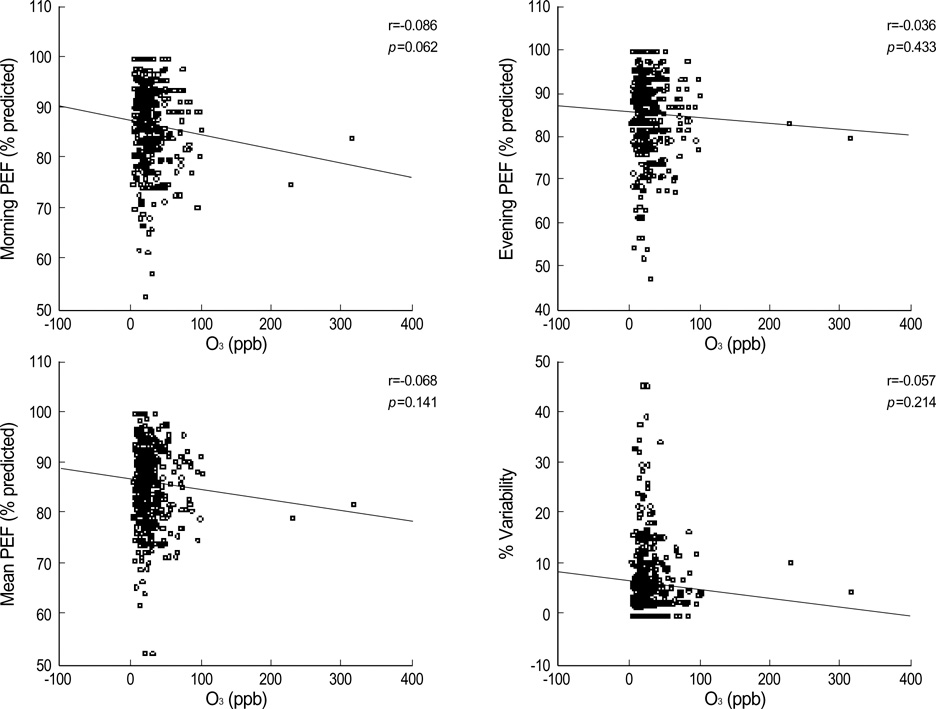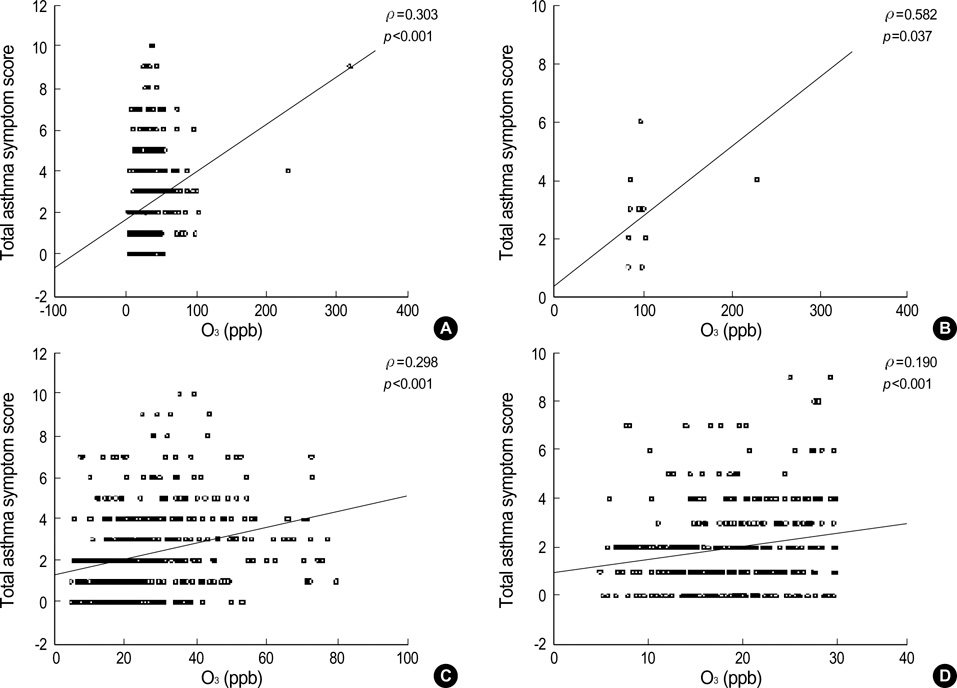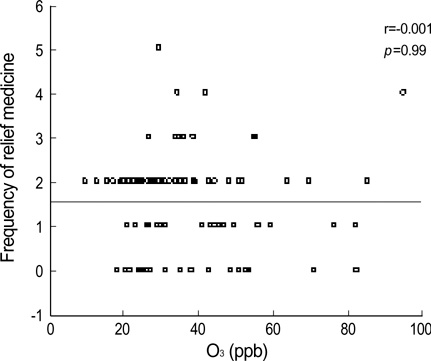J Korean Med Sci.
2007 Feb;22(1):30-36. 10.3346/jkms.2007.22.1.30.
The Effects of On-site Measured Ozone Concentration on Pulmonary Function and Symptoms of Asthmatics
- Affiliations
-
- 1Department of Internal Medicine, Dankook University College of Medicine, Cheonan, Korea. ykjee@dankook.ac.kr
- 2Department of Preventive Medicine, Dankook University College of Medicine, Cheonan, Korea.
- 3Department of Internal Medicine, Konkuk University College of Medicine, Seoul, Korea.
- 4Cheongju St. Mary's Hospital, Cheongju, Korea.
- KMID: 1713226
- DOI: http://doi.org/10.3346/jkms.2007.22.1.30
Abstract
- Most studies on the effects of ambient ozone on asthmatics have been based on ozone concentration measurements taken by air monitors in downtown areas. Using a passive ozone sampler, we investigated the effects of on-site ozone concentrations on the pulmonary function and symptoms of asthmatics. Twenty moderate to severe asthmatics who had been managed for at least 2 months without changes of their medication were enrolled from 3 June to 18 July 2005. Respiratory, nasal and ocular symptoms, peak expiratory flow (PEF), which was measured twice a day, and medication use were recorded on a daily basis during the study period. Data for 17 subjects were analyzed. The average ozone exposure level was 28.2+/-23.6 ppb (3.4-315.3 ppb). There was no significant correlation between PEF and ozone concentration (p>0.05) on the same day or 1-, 2-, or 3-day lags. Interestingly, the degree of asthma symptoms was influenced by the ozone concentration (rho=0.303, p<0.001), even at concentrations less than 80 ppb (p=0.298, p<0.001), but the correlation between ozone exposure and the frequency of reliever medication use was not statistically significant (p=0.99). Our results suggest that exposure to relatively low concentrations of ozone influences the symptoms of moderate to severe asthmatics regardless of changes in pulmonary function or medication use.
Keyword
MeSH Terms
Figure
Reference
-
1. Burney P. The changing prevalence of asthma? Thorax. 2002. 57:II36–II39.2. Peel JL, Tolbert PE, Klein M, Metzger KB, Flanders WD, Todd K, Mulholland JA, Ryan PB, Frumkin H. Ambient air pollution and respiratory emergency department visits. Epidemiology. 2005. 16:164–174.
Article3. Committee of the Environmental and Occupational Health Assembly of the American Thoracic Society. Health effects of outdoor air pollution. Am J Respir Crit Care Med. 1996. 153:3–50.4. Committee of the Environmental and Occupational Health Assembly of the American Thoracic Society. Health effects of outdoor air pollution. Part 2. Am J Respir Crit Care Med. 1996. 153:477–498.5. Peden DB. Adkinson NF, Yunginger JW, Busse WW, Bochner BS, Holgate ST, Simons FE, editors. Air pollution: indoor and outdoor. Middleton's Allergy: Principle and Practice. 2003. 6th edition. Philadelphia, PA: Mosby;515–528.
Article6. Peden DB. Air pollution in asthma: effect of pollutants on airway inflammation. Ann Allergy Asthma Immunol. 2001. 87:12–17.
Article7. Forster J, Kuehr J. The role of ozone. Pediatr Allergy Immunol. 2000. 11:23–25.
Article8. Standards for the diagnosis and care of patients with chronic obstructive pulmonary disease (COPD) and asthma. This official statement of the American Thoracic Society was adopted by the ATS Board of Directors, November 1986. Am Rev Respir Dis. 1987. 136:225–244.9. Yim BM, Jung ES, Kim ST. Development of a passive sampler using a fluorescence material for the ambient ozone. J Korean Soc Atmos Environ. 2004. 20:1–9.10. Cassino C, Ito K, Bader I, Ciotoli C, Thurston G, Reibman J. Cigarette smoking and ozone-associated emergency department use for asthma by adults in New York City. Am J Respir Crit Care Med. 1999. 159:1773–1779.
Article11. Boutin-Forzano S, Adel N, Gratecos L, Jullian H, Garnier JM, Ramadour M, Lanteaume A, Hamon M, Lafay V, Charpin D. Visits to the emergency room for asthma attacks and short-term variations in air pollution. A case-crossover study. Respiration. 2004. 71:134–137.12. Friedman MS, Powell KE, Hutwagner L, Graham LM, Teague WG. Impact of changes in transportation and commuting behaviors during the 1996 summer Olympic Games in Atlanta on air quality and childhood asthma. JAMA. 2001. 285:897–905.
Article13. Mortimer KM, Neas LM, Dockery DW, Redline S, Tager IB. The effect of air pollution on inner-city children with asthma. Eur Respir J. 2002. 19:699–705.
Article14. Gent JF, Triche EW, Holford TR, Belanger K, Bracken MB, Beckett WS, Leaderer BP. Association of low-level ozone and fine particles with respiratory symptoms in children with asthma. JAMA. 2003. 290:1859–1867.
Article15. Holz O, Mucke M, Paasch K, Bohme S, Timm P, Richter K, Magnussen H, Jorres RA. Repeated ozone exposures enhance bronchial allergen responses in subjects with rhinitis or asthma. Clin Exp Allergy. 2002. 32:681–689.
Article16. Kehrl HR, Peden DB, Ball B, Folinsbee LJ, Horstman D. Increased specific airway reactivity of persons with mild allergic asthma after 7.6 hours of exposure to 0.16 ppm ozone. J Allergy Clin Immunol. 1999. 104:1198–1204.
Article17. Devlin RB, McDonnell WF, Mann R, Becker S, House DE, Schreinemachers D, Koren HS. Exposure of humans to ambient levels of ozone for 6.6 hours causes cellular and biochemical changes in the lung. Am J Respir Cell Mol Biol. 1991. 4:72–81.
Article18. Vagaggini B, Taccola M, Cianchetti S, Carnevali S, Bartoli ML, Bacci E, Dente FL, Di Franco A, Giannini D, Paggiaro PL. Ozone exposure increases eosinophilic airway response induced by previous allergen challenge. Am J Respir Crit Care Med. 2002. 166:1073–1077.
Article19. Bosson J, Stenfors N, Bucht A, Helleday R, Pourazar J, Holgate ST, Kelly FJ, Sandstrom T, Wilson S, Frew AJ, Blomberg A. Ozone-induced bronchial epithelial cytokine expression differs between healthy and asthmatic subjects. Clin Exp Allergy. 2003. 33:777–782.
Article20. Jakab GJ, Hemenway DR. Concomitant exposure to carbon black particulates enhances ozone-induced lung inflammation and suppression of alveolar macrophage phagocytosis. J Toxicol Environ Health. 1994. 41:221–231.
Article21. Jang AS, Choi IS, Takizawa H, Rhim T, Lee JH, Park SW, Park CS. Additive effect of diesel exhaust particulates and ozone on airway hyperresponsiveness and inflammation in a mouse model of asthma. J Korean Med Sci. 2005. 20:759–763.
Article22. Ministry of the Environment. Monthly Report of Air Quality. 2005. Seoul, Korea: MOE.
- Full Text Links
- Actions
-
Cited
- CITED
-
- Close
- Share
- Similar articles
-
- Pulmonary Function Changes of Ozone Exposed Workers in a Film Manufacturing Company
- Changes of Lung Function and Symptoms of Asthmatics according to the Concentration of On-site Measured NO2
- Impact of ozone on circulating tight junction protein claudin 4 and claudin 5 in patients with asthma
- Airway Obstruction after Acute Ozone Exposure in BALB/c Mice Using Barometric Plethysmography
- Health Effects of Ozone on Respiratory Diseases




